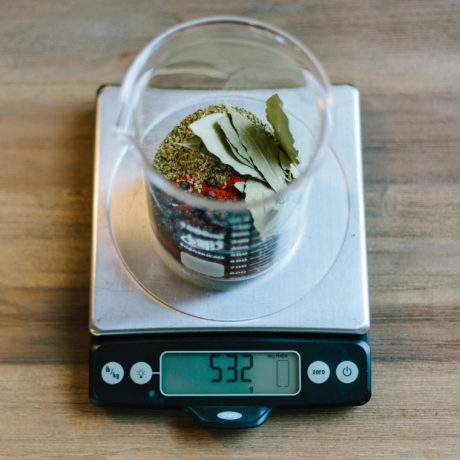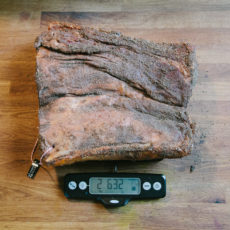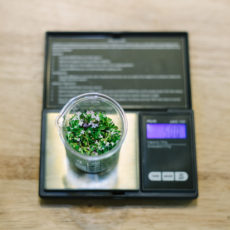
One of the single best things you will ever do for your cooking is to switch from volume measurement (2 cups, ½ teaspoons, etc.) to weight measurement (1kg, 2.2lbs, etc). Measuring by weight is more precise, significantly faster, and requires exponentially less cleanup.
Why Measure by Weight?
Precision. My cup of flour, is likely not your cup of flour. Let’s say I pack a cup of flour and the resulting amount, by weight, is 155 grams. Then you pack the same cup, but arrive at 130 grams—a 25 gram difference. Maybe that doesn’t sound like a lot, but what if the recipe calls for 4 cups? You’ve now got a 100 gram difference, which is about ¾ cup, more or less. And then there’s the question of “What did the recipe author intend? Was their cup closer to 155g, or was it 130g—or was it somewhere between?” And if you’re feeding a crowd? These inaccuracies only compound as you scale. The fine folks over at ChefSteps have done an excellent job of illustrating this.
To make matters worse standard volume measurements differ from country to country. In the US a Tablespoon is 14.79 mL, in Australia 20 mL, and in the UK and Canada 15mL. Moreover, a cup is 236.59 mL in the US, 284.1 mL in the UK, and 250 mL in Australia.
Then there are tasks that require minute precision, like weighing emulsifiers, or thickeners, which are typically introduced at tenths of a gram. Would that be 1/24th of a teaspoon? In salumi we typically use curing agents like sodium nitrite at 0.25% of total meat weight. When curing a 1kg piece salume, that’s only 2.5 grams. And considering nitrite can be deadly when used at too large of quantity, accuracy is of paramount importance.
Speed
Maybe you don’t care about accuracy and are not baking, cooking or curing where precision is important. All fine, but consider this: A key benefit of measurement by weight is speed. Weighing the ingredients of a recipe is significantly faster. Again, something ChefSteps has documented. When weighing we typically set a single vessel on a scale and add ingredients progressively, pouring directly from the container or bag important source. This does away with the litany of measuring cups and spoons. Further, it eliminates the time to clean and dry those utensils between liquid and dry ingredients.
Most of us have had to scale a recipe up or down. Say you’re cooking for a large party and need to scale up by 7x. This is another way in which weight (and the metric system!) excels. 7x ¾ cup is … uh, 5 and ¼ cups?. Where 7x 100g is 700g. The former requires that we go through the recipe, line-by-line, doing the conversion math. The latter is easy to do on the fly in your head.
Cleanup
In addition to speed of prep, cleanup is drastically reduced. With weight measurement we are only using the vessel in which we are measuring ingredients into. With volume we have a dozen different items to clean. Or maybe you like cleaning?
Switching to the weight method of measurement has been one of the most significant milestones in my evolution as a cook. I’ve yet to find a single person that has ever “gone back.” I doubt I ever will. As for the investment, the cost of an accurate kitchen scale is around $20. The cost of a quality set of measuring cups and spoons is about the same.
Kitchen Scales
I switch between 3 different scales. This is not strictly necessary, but it’s what works best for me. For many, a single high-capacity scale with a 1g accuracy is sufficient. If you are working with ingredients that require precision measurement, at small quantities, you will want to invest in a small precision scale with a 0.01g accuracy.
Most scales, regardless of quality, lose a bit of accuracy over time and require calibration. Calibration is as easy as purchasing a calibration weight and pressing a button or two. Most scales require a particular weight (e.g. 50g, 100g, etc.). It’s a good idea to purchase the required weight at the time of purchasing the scale. This will allow you to confirm that it is indeed calibrated correctly and allow you to check and calibrate whenever necessary.
There are a lot of excellent scales from a myriad of different manufacturers out there. The following are the scales I use and recommend.
High-Capacity Scale
OXO Good Grips Food Scale w/ Pull-Out Display
Max weight: 5kg / 11lbs.; Accuracy: 1g / 0.25oz.
I’ve had this scale for 4+ years and I’ve not treated it gingerly. It gets beat up and tossed around the kitchen and still works like a champ. As of this post a 100g calibration weight confirms it’s still right on the money. The stainless steel top pops off for easy cleaning and the front display pulls out for times when your ingredient is larger than the scale. Since I’ve purchased this, OXO has released a 10kg/22lb. increased capacity version for $10 more. If this scale ever fails me, I will opt for the increased capacity.
Calibration: The OXO scale does not indicate that it can be calibrated.
Medium-Capacity, Precision Scale
American Weigh Scales AMW-SC-2KG
Max weight: 2kg / 4.4lbs.; Accuracy: 0.1g / 0.01oz.
This scale is small, about the size of my palm (I do have large hands). It’s a great scale for typical, medium duty tasks where 0.1g resolution is sufficient. American Weigh Scales (AWS) make excellent scales. I typically use this scale for weighing spices and herbs. It also comes with a plastic case that doubles as container to measure ingredients. At times when the OXO is not precise enough, I reach for this scale.
Calibration: One or Two 1,000g weight(s) (one 1,000g weight for one-point calibration; or two for two-point calibration)
Ultra-Precision Scale
American Weigh 100g x 0.01g
Max weight: 100g / 3.5oz.; Accuracy: 0.01g / 0.00035oz.
This is an extremely accurate scale and best suited for precision tasks like weighing emulsifiers, thickeners and curing ingredients. The scale comes with a handy hinged cover and can be calibrated with a 100g weight. The only thing more impressive than the 0.01g accuracy, is the $12 price tag.
Calibration: One 100g weight
13 Comments
-
Kyle, I too love my OXO scale. I must admit I don’t bother with scales for herbs and spices, but I certainly would if I were cooking in great quantities. The scale gets daily use, and I’d say it’s one of my favorite kitchen tools.
-
Author
That’s great to hear. Thanks for sharing.
-
Kyle,
The only issue I have with taking the scale plunge is most recipes are already written in pounds, ounce, cups and spoons. What exactly should all of the common measurement for say a cup, a tablespoon and a teaspoon That way I can go ahead and convert all or most of my recipes to measure the ingredients by weight and not volume. Does the density of the ingredient make a difference in it’s dry weight also. For example does a cup of flour equal the same as a cup of cooked and drained ground beef? How do I arrive at a good average or actual weight to make the switch???
Wheelchair Bob-
Author
Bob — First, thanks for all of your contributions lately. I appreciate it. Now to answer your question:
That’s the hard(er) part. Somewhere along the line we (Americans) got talked into writing recipes in volume measurements (don’t even get me started on the ludicracy of the Imperial system!). Now, as a recipe writer, is often considered a requirement when writing recipes for non-professionals. Most modern cookbooks will give you both volume and weight measurements.
As you mention, the density does make a difference. This is one of the huge flaws in communicating measurements in volume. For example, a cup of kosher salt has significantly less sodium chloride (resulting from grain size), than a cup of table salt. BUT, 100grams of kosher salt has the exact same sodium chloride as 100grams of table salt.
If you are converting your own recipes, or recipes you make often, you may consider measuring by volume, then dumping into a bowl on your scale and recording the weight. There are a lot of places on the web that will give basic weight equivalents of common ingredients. This may be a good place to start.
I promise you. If you make the commitment to switching, you’ll never regret it.
-
-
-
I dig my scales. Problem is, I’ve burned through a few of them. Hard to tell what’s what in the consumer-level realm. A $60 one here or a $30 one there. If there were a defacto-standard that was $150 and got rave reviews, I’d lay the money down. I don’t mind paying for something that I know would hold up through the years. Guess I just got a few eBay bombs. But, I agree, scales are essential. Nice post.
-
Author
I know two others with the OXO scale that have had them for 4-5 years. Used every day. No issues. Even same battery. If that’s helpful. Thanks, Jason.
-
-
I love the pull out display on those scales. I’m forever trying to find a plate to put on top of my scales so that I can see the screen.
-
Author
it’s one of those things I didn’t think I would use, but have ended up using all the time. It’s super handy.
-
-
Super helpful! Thanks so much!
-
Author
Thanks!
-
-
It’s amazing for me to have a web site, which is valuable in favor of my experience.
thanks admin -
Having a scale that can measure accurately weights that are less than ounces is important and can better help with cooking. I like the fact that it can speed up the process as you mentioned. With recipes today, a lot of ingredients are measure in grams rather than the metric system. If I were in the medical field, I think that gram scales would be beneficial. There are a lot of medications or fluids that have to be used and having a precise weight is very important. I think a lot of people could benefit from something like this.
-
Hi, and god job @kylehildebrant, Me, Selva, from Catalonia, Spain. I am in the making of cured meats.



